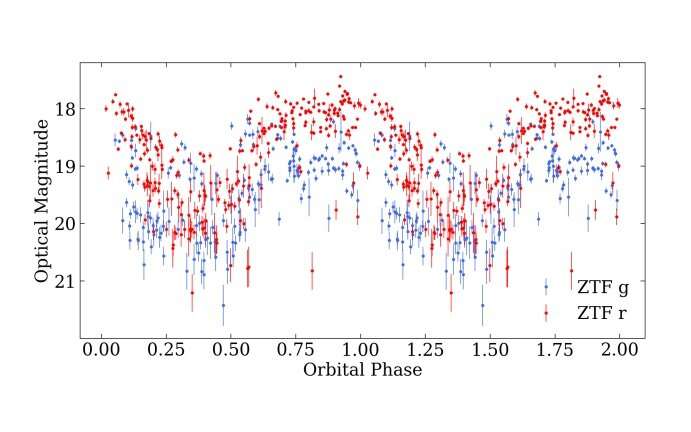June 20, 2022 report
Astronomers discover two new polars

By analyzing the data from the Spektr-RG (SRG) space observatory and from the Zwicky Transient Facility (ZTF), astronomers from the California Institute of Technology (Caltech) and elsewhere have discovered two new polars. The discovery is reported in a paper published June 9 on the arXiv pre-print repository.
Cataclysmic variables (CVs) are binary star systems comprising a white dwarf and a normal star companion. They irregularly increase in brightness by a large factor, then drop back down to a quiescent state. Polars are a subclass of cataclysmic variables distinguished from other CVs by the presence of a very strong magnetic field in their white dwarfs.
Now, a team of astronomers led by Caltech's Antonio C. Rodriguez has found two new polars, which received designation ZTFJ0850+0443 and ZTFJ0926+0105. The detection is a result of crossmatching the eROSITA Final Equatorial Depth Survey (eFEDS) catalog with forced photometry of ZTF Data Release 5 (DR5).
"We have discovered two polars: ZTFJ0850+0443 and ZTFJ0926+0105, through a crossmatch of the eFEDS dataset and ZTF archival photometry," the researchers wrote in the paper.
According to the study, ZTFJ0850+0443 is an eclipsing polar with an orbital period of 1.72 hours, at a distance of some 3,260 light years away from the Earth. Its white dwarf has a mass of about 0.81 solar masses, while the companion star's mass was estimated to be approximately 0.12 solar masses. The results suggest that ZTFJ0850+0443 is likely a low-field polar with magnetic field strength below 10 MG.
At a distance of about 1,200 light years, ZTFJ0926+0105 is a non-eclipsing polar with an orbital period of about 1.48 hours. It has a more typical magnetic field strength of polars—at least 26 MG. Given that ZTFJ0926+0105 is not eclipsing, the team was not able to measure the mass of its white dwarf.
The astronomers concluded that their discovery shows how important the eFEDS survey is in supplementing ZTF for the detection of new cataclysmic variables. Moreover, they added that by making use of ESA's Gaia satellite, it will be possible to obtain precise luminosities of the newfound polars. The recent Gaia Data Release 3 (DR3), published June 13, may be very useful in this context.
"Schwope et al (2021) identified an eclipsing polar through an eROSITA/SRG crossmatch with Gaia using a proprietary eRASS dataset," the scientists noted.
The research conducted by Rodriguez's team is part of a larger follow-up analysis of the eFEDS/ZTF footprint. Such studies could be useful in overcoming observational biases in previous optical-only searches for cataclysmic variables, and would directly lead to accurate volume-limited studies of CVs.
More information: Antonio C. Rodriguez et al, Discovery of Two Polars from a Crossmatch of ZTF and the SRG/eFEDS X-ray Catalog. arXiv:2206.04714v1 [astro-ph.HE], arxiv.org/abs/2206.04714
© 2022 Science X Network




















